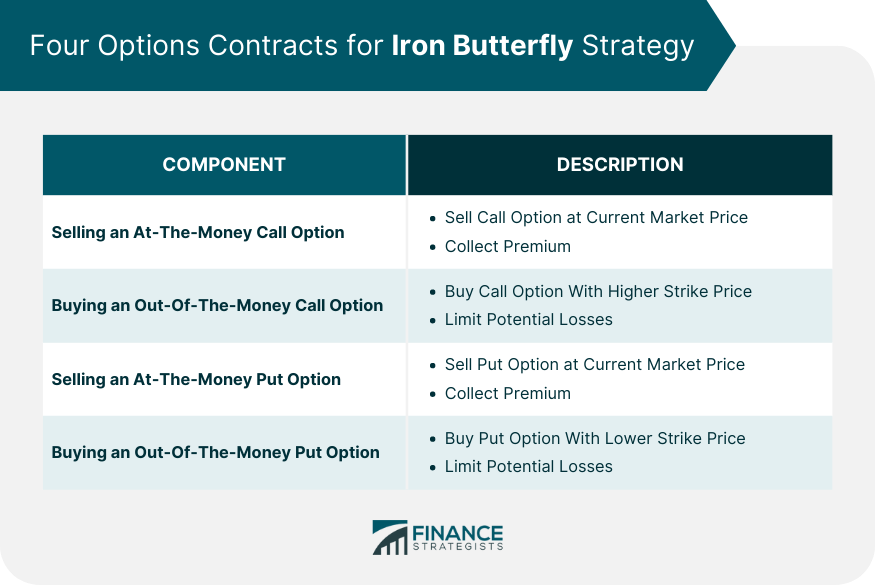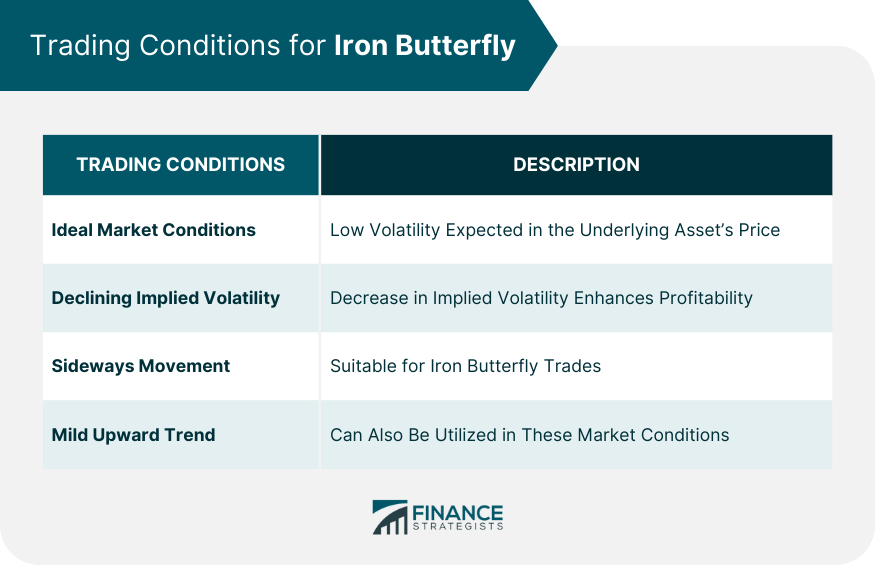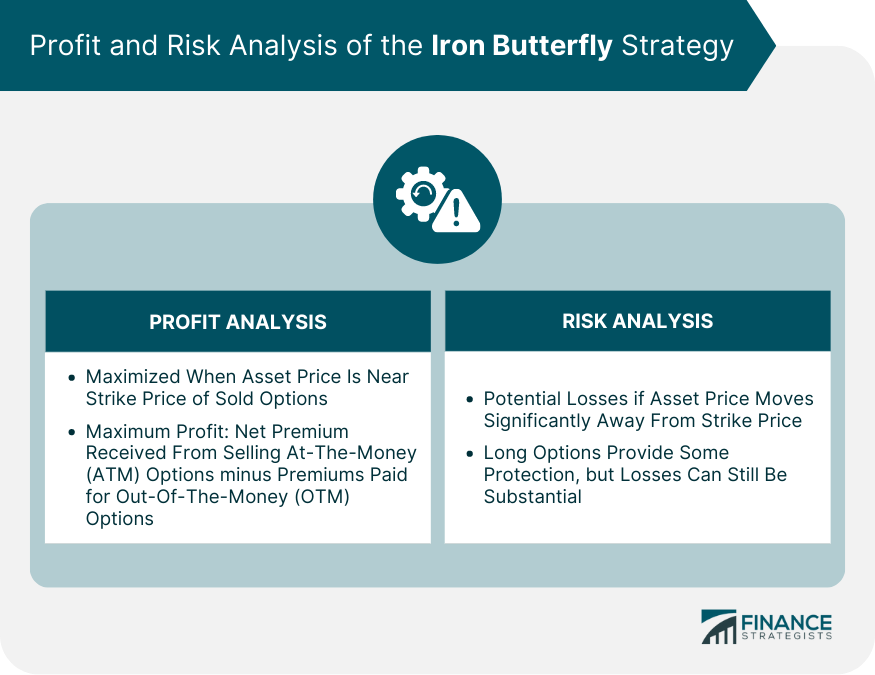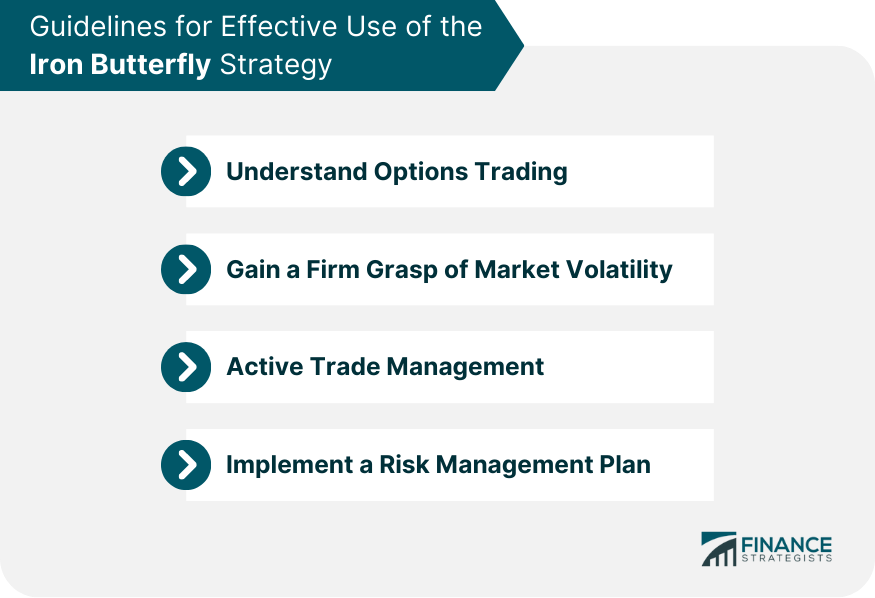Iron Butterfly is an options trading strategy that involves the simultaneous purchase of both a long straddle and a short straddle. It is a neutral strategy used when the trader expects little to no movement in the underlying asset's price. The long straddle consists of buying a call option and a put option with the same strike price and expiration date, while the short straddle involves selling a call option and a put option with the same strike price and expiration date. This combination creates a limited-risk position with a capped profit potential. The goal of an iron butterfly strategy is for the underlying asset's price to remain within a specific range, allowing the trader to profit from time decay. An integral part of the Iron Butterfly strategy is selling an at-the-money (ATM) call option. This contract gives the buyer the right, but not the obligation, to buy the underlying asset at the strike price, which in this case, is identical to the current market price. As a seller, the trader collects a premium, which is maximized if the price of the underlying asset remains close to the strike price at expiration. The next step in the Iron Butterfly strategy is buying an out-of-the-money (OTM) call option. This contract has a strike price higher than the current market price of the underlying asset. This OTM call option acts as a protective wing, limiting the potential loss if the price of the underlying asset significantly increases. The trader pays a premium for this protection, which is part of the cost of establishing the Iron Butterfly position. The third component of the Iron Butterfly strategy involves selling an ATM put option. This contract gives the buyer the right to sell the underlying asset at the strike price, which is identical to the current market price. As the seller of this option, the trader collects a premium, adding to the potential profit if the underlying asset's price remains close to the strike price at expiration. Finally, the trader buys an OTM put option, which has a strike price lower than the current market price of the underlying asset. This option serves as another protective wing, limiting the potential loss if the price of the underlying asset falls significantly. The trader pays a premium for this protection. At first glance, the Iron Butterfly may seem similar to a short straddle strategy. Both strategies involve selling an ATM call and put. However, the key difference lies in the Iron Butterfly's use of OTM options to limit risk. By buying an OTM call and put, the Iron Butterfly trader caps the potential losses from large price movements in the underlying asset. This is in contrast to a short straddle, where the risk is theoretically unlimited. The long call and put options in the Iron Butterfly strategy act as a safeguard against significant price movements in the underlying asset. The long call option provides protection against a steep rise in the asset's price, while the long put option provides a safety net against a dramatic drop in the asset's price. Without these protective wings, the trader would face potentially unlimited losses, making the strategy much riskier. The ideal market condition for implementing an Iron Butterfly strategy is when the trader expects low volatility in the underlying asset's price. This is because the maximum profit for this strategy is realized when the asset's price remains close to the strike price of the sold call and put options at expiration. Thus, a market characterized by small price movements is the perfect breeding ground for an Iron Butterfly trade. Implied volatility is a critical factor when considering an Iron Butterfly trade. A decline in implied volatility, or the market's expected future volatility, can increase the profitability of the strategy. This is because a decrease in volatility often leads to a reduction in options premiums, which can enhance the potential profits of the sold call and put options. Iron Butterfly trades are typically used during periods of sideways market movement or a mild upward trend. During these periods, the underlying asset's price remains relatively stable, which aligns well with the Iron Butterfly strategy's requirement for low volatility. Traders can profit from the Iron Butterfly strategy when the underlying asset's price at expiration is close to the strike price of the sold call and put options. The maximum profit is the net premium received from selling the ATM call and put options, minus the premiums paid for the OTM call and put options. While the Iron Butterfly strategy can offer attractive profits, it also comes with potential risks. The most significant risk is the potential for losses if the underlying asset's price moves significantly away from the strike price of the sold options. Although the long call and put options limit these losses, they can still be substantial. Traders can limit the risks associated with the Iron Butterfly strategy by properly managing their positions. This includes using stop-loss orders to limit potential losses, adjusting the position as market conditions change, and ensuring that the trade's potential profit outweighs its potential risk. As the Iron Butterfly strategy involves four options contracts, commission costs can be a significant consideration. Traders must ensure that the potential profit from the trade outweighs the commission costs. If the underlying asset's price at expiration is equal to the strike price of the sold call or put option, the trader could be obligated to buy or sell the underlying asset. Traders must be prepared for this possibility and have a plan in place to manage it. To effectively use the Iron Butterfly strategy, traders should understand options trading, have a firm grasp of market volatility, and be willing to actively manage their trades. They should also have a risk management plan in place to limit potential losses. Before diving into complex strategies like the Iron Butterfly, traders must first have a solid understanding of options trading. This includes knowing the difference between call and put options, comprehending concepts like strike price and expiration date, and understanding how to read an options chain. After mastering the basics, traders should familiarize themselves with advanced strategies, like the Iron Butterfly. They should understand how the strategy works, the ideal market conditions for implementing it, and the risks involved. Market volatility is a key factor when trading options. Traders must understand how volatility affects options prices and how it can influence the profitability of strategies like the Iron Butterfly. Traders should also monitor volatility trends in the market. Periods of high volatility may not be the best time to implement an Iron Butterfly, as the strategy thrives in low volatility conditions. Actively managing trades is critical when using the Iron Butterfly strategy. This can involve adjusting the position as market conditions change to protect profits or limit losses. Staying updated with relevant market news and events can help traders make informed decisions about when to adjust their positions. A risk management plan is crucial when trading options. Such a plan can help traders limit potential losses and protect their trading capital. A good risk management plan should include stop-loss orders, position sizing strategies, and a clear exit strategy. Traders should also have contingency plans in place for unexpected market events. The Iron Butterfly is an options trading strategy designed to profit from low volatility in the underlying asset's price. It involves selling an ATM call and put option, and buying an OTM call and put option. The strategy profits when the underlying asset's price remains close to the strike price of the sold options at expiration. Understanding the mechanics of the Iron Butterfly is crucial for its successful implementation. The interplay of the four contracts and the role of each in the overall profitability of the strategy can greatly influence the trade's outcome. It's also vital to comprehend how the Iron Butterfly compares to similar strategies and how the long call and put options serve as protective wings. Identifying the ideal market conditions for the Iron Butterfly is paramount. These conditions typically involve low volatility and periods of sideways market movement or a mild upward trend. Also, a keen understanding of the implications of declining implied volatility can help enhance the strategy's profitability.What Is Iron Butterfly?
Mechanics of the Iron Butterfly Trade
Breakdown of the Iron Butterfly Strategy
Selling an At-The-Money Call Option
Buying an Out-Of-The-Money Call Option
Selling an At-The-Money Put Option
Buying an Out-Of-The-Money Put Option

Comparisons to Similar Trading Strategies
Role of Long Call and Long Put Options in the Trade
Trading Conditions for Iron Butterfly
Ideal Market Conditions for an Iron Butterfly Trade
Importance of Declining Implied Volatility for the Strategy
Typical Scenarios: Periods of Sideways Movement or a Mild Upward Trend

Profit and Risk Analysis of the Iron Butterfly Strategy
How Traders Can Profit From the Iron Butterfly Strategy
Potential Risks and Drawbacks of the Iron Butterfly Strategy

How Traders Can Limit Risks Associated With the Strategy
Practical Considerations for Traders
Considerations Regarding Commissions for the Iron Butterfly Trade
Potential Implications of the Strategy on Acquiring Stock Post-Expiration
Guidelines for Effective Use of the Iron Butterfly Strategy
Understand Options Trading
Gaining a Firm Grasp of Market Volatility
Active Trade Management
Implementing a Risk Management Plan

Final Thoughts
Iron Butterfly FAQs
An Iron Butterfly is a limited risk, limited reward options trading strategy designed to profit when the underlying asset is expected to have low volatility. It involves four options contracts: selling an ATM call and put option, and buying an OTM call and put option.
The Iron Butterfly strategy profits when the underlying asset's price at expiration is close to the strike price of the sold call and put options. The maximum profit is the net premium received from selling the ATM call and put options, minus the premiums paid for the OTM call and put options.
The primary risk with the Iron Butterfly strategy is that the underlying asset's price will move significantly away from the strike price of the sold options. Although the losses are limited by the long call and put options, they can still be substantial.
Implied volatility plays a crucial role in the Iron Butterfly strategy. If the implied volatility decreases, it can lead to a reduction in options premiums, which can enhance the potential profits of the sold call and put options.
Yes, if the underlying asset's price at expiration is equal to the strike price of the sold call or put option, the trader could be obligated to buy or sell the underlying asset. Traders must be prepared for this possibility and have a plan to manage it.
True Tamplin is a published author, public speaker, CEO of UpDigital, and founder of Finance Strategists.
True is a Certified Educator in Personal Finance (CEPF®), author of The Handy Financial Ratios Guide, a member of the Society for Advancing Business Editing and Writing, contributes to his financial education site, Finance Strategists, and has spoken to various financial communities such as the CFA Institute, as well as university students like his Alma mater, Biola University, where he received a bachelor of science in business and data analytics.
To learn more about True, visit his personal website or view his author profiles on Amazon, Nasdaq and Forbes.













